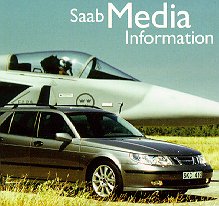

SAAB 9-5 IN THE REAR-VIEW MIRROR
NORCROSS, Ga. - The Saab 9-5 sedan was launched in the U.S. as a 1999 model, breaking new ground for Saab. It was the first large car Saab had launched since the 9000 hatchback in 1986 - and it was a sedan, not a hatchback. The Saab 9-5 effectively underscored Saab's commitment to the mid-luxury market segment, offering a highly individual alternative to other premium rivals, with performance and safety top of its agenda.
The engine line-up was all-turbocharged. There was a 2.3-liter four-cylinder Ecopower engine (170 hp) as well as the world's first asymmetrically turbocharged V6 engine, a 3.0-liter with 200 hp. Engine management was by Saab's own 32-bit Trionic management system, along with Direct Ignition for each of the cylinders to enhance performance and reduce emissions.
But it was the standard safety levels, based on Saab's real-life safety strategy, which really catapulted the 9-5 into the limelight. It featured an impressive central safety cage with exterior crumple zones designed to deform along pre-set load paths, to channel impact energy away from the Saab's occupants.
SAHR wins Safety Achievement Award
The 9-3 also featured the pioneering Saab Active Head Restraint system (SAHR) designed to minimize whiplash injuries. Saab was recognized at the 2001 World Traffic Safety Symposium in New York as the winner of the 2001 Safety Achievement Award based on the development and implementation of the SAHR system.
Safety systems in the Saab 9-5 were developed in line with Saab's Real-Life Safety concept - cars must be as safe as possible in a variety of accident situations. Since 1972, Saab has investigated more than 6,000 accidents involving Saabs in Sweden. In addition to providing invaluable information regarding the real-life crash safety properties of Saab cars, this data also helps Saab engineers perform more realistic crash tests.
Safest car tested by EuroNCAP in 2000
The result of such a high level of safety engineering was the first ever EuroNCAP four-star rating - the top level of crashworthiness. Following the tests last year, the EuroNCAP consortium stated that the Saab 9-5 was the safest car they had ever tested. The EuroNCAP consortium is comprised of the Swedish Road
Administration, the British and Dutch Ministries of Transport, the EU Commission, Federation Internationale de l'Automobile (FIA), Allgemeiner Deutscher Automobil- Club e V (ADAC), Alliance Internationale de Tourisme (AIT) and International Consumer Research and Testing (ICRT).
Saab 9-5 tops mid-luxury segment in J.D. Power quality study Saab has made the pursuit of world-class quality a corporate-wide objective - one that was independently recognized in 2001. The Saab 9-5 sedan and wagon were ranked as the Best Mid-Luxury Car in the 2001 J.D. Power and Associates Initial Quality Study (IQS). The J.D. Power IQS measures owner-reported problems during the first three months of ownership.
Crafted functionality
Saabs have always been renowned as outstanding long-distance driving machines; the combination of effortless turbo power, supremely comfortable seats, and a well-designed interior receiving much of the credit. To this, Saab engineers added extra functionality on the 9-5, characterized by typically thoughtful Swedish design, such as the sculpted simplicity of the head restraints.
Other examples of form with function included the elegant cupholder, which folded out vertically from the instrument panel, before pirouetting horizontally to provide a drink receptacle. Or the dual-zone heating system, which created one ventilation zone for the driver and another for the front and rear occupants. Or the chilled glovebox. Or the fan-assisted ventilated leather seats, the first time these had been available on a car.
Extra versatility arrives with the launch of the Saab 9-5 wagon
The Saab 9-5 range was extended in 2000 with the launch of the station wagon variant. Although the car was designed to carry extra loads, the emphasis was on providing an exceptionally sporty driving experience. Like the original sedan's low aerodynamic Cd factor of 0.29, the wagon featured a highly competitive 0.31 Cd. Of course, the wagon was engineered to Saab's exceptionally high standards and featured plenty of innovations. These included tie-down CargoTracks, similar in design to those produced for aircraft use. They were so strong they could even support the car's weight if hoisted up by a crane.
Aero provides sporting flagship
The current Saab 9-5 line-up was completed in 2000 by the launch of the no- holds-barred Saab 9-5 Aero sedan and wagon with a blistering 2.3-liter High-Output Turbo (HOT) four-cylinder engine, with a potent 230 hp and 258 lb.-ft. of torque. Actually, a turbo overboost function allowed the turbo to boost torque to 273 lb.-ft. for a 20-second burst for safer passing power. Featuring a lowered and firmer riding chassis, the Aero came with standard traction control, 17-inch Aero alloy wheels and aerodynamic body styling.
For more than 50 years, Saab has been designed cars that are a unique alternative to ordinary, mainstream automobiles. For 2002, the 9-5 sedan and 9-5 SportWagon evolve into nothing less than the most distinctive, dynamic cars ever produced by Saab.
 |
 |
 |
 |
 |
